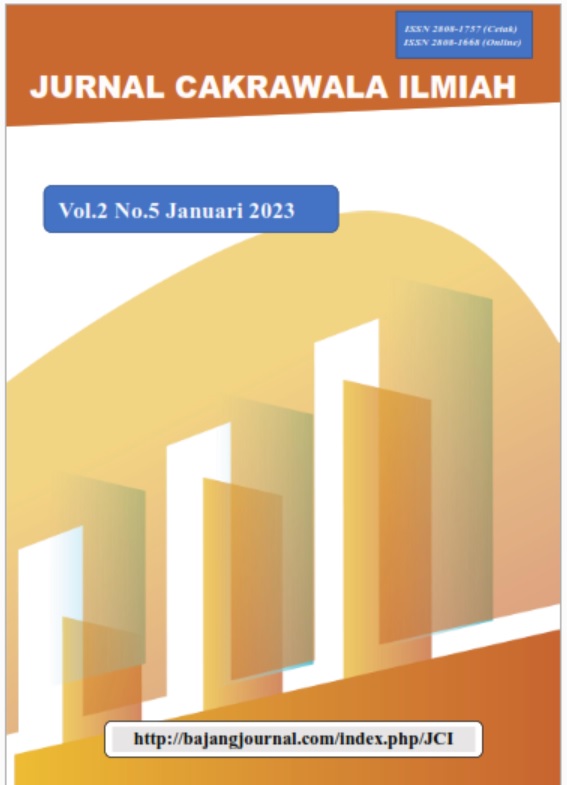KONSEP DAN STRATEGI PENDIDIKAN AGAMA ISLAM DI PERGURUAN TINGGI UMUM
(Studi Tentang Penerapan Mata Kuliah PAI di Universitas Pasundan Bandung)
DOI:
https://doi.org/10.53625/jcijurnalcakrawalailmiah.v2i5.4615Keywords:
Globalization, Islamic Religious Education, Higher EducationAbstract
The development of world civilization in the era of globalization shows two opposite sides of a coin. On the one hand, the inhabitants of the earth are increasingly spoiled by technological achievements that make it easier for anyone to access information and communicate with anyone in any part of the world. On the other hand, the inhabitants of the earth are increasingly losing their individual identities. Local culture that has wisdom values is increasingly being marginalized, replaced by a hedonic culture, promiscuity, and a culture that is far from polite. Educational institutions are parties that should take a role in overcoming the problems of the community. Higher education as a center of excellence is the hope for a better future. Universities will become institutions that give birth to cadres of national fighters who are ready to be involved in carrying out development agendas. Religious education in tertiary institutions aims to help orderly students who have faith and are devoted to God Almighty, have noble character, think philosophically, be rational and dynamic, have broad views, participate in inter-religious cooperation in the framework of developing and utilizing science and technology and art for human and national interests. Islamic religious education in tertiary institutions is considered capable of tackling student moral degradation such as brawls, drug consumption, alcohol, free sex and so on. The portrait of the implementation of Islamic Religious Education in Higher Education is an interesting object to study. In this case, research was conducted at Pasundan University using research through information sources from online media and directly involved in the research location. The research results are presented with a descriptive analytic pattern.
References
Arifin, Muzayyin, 2008. Kapita Selekta Pendidikan Islam (Jakarta : PT. Bumi Aksara
Balai Penelitian dan Pengembangan Agama Jakarta, 2009. Pendidikan Agama Islam dalam Perspektif Multikulturalisme. Jakarta: PT. Saadah Cipta Mandiri,
Rohim, A. 2016. Peranan Pendidikan Agama Islam (PAI) di Perguruan Tinggi Melalui Pendekatan Fenomenologis. Nidhomul Haq
Komaruddin Hidayat, 2001.“Reposisi Studi Islam di Perguruan Tinggi,” pengantar untuk Buku Teks Pendidikan Agama Islam Pada Perguruan Tinggi Umum, yang diterbitkan oleh Direktorat Perguruan Tinggi Agama Islam Direktorat Jenderal Kelembagaan Agama Islam Departemen Agama RI, tahun
Luthfi, R. 2012. Strategi Pembelajaran Pendidikan Agama Islam di Perguruan Tinggi Negeri. Thesis
M. Karman, “Reorientasi Pendidikan Agama di Perguruan Tinggi Umum” dalam situs http://didaktika.fitkuinjkt.ac.id/. )
Mastuhu,1999. Memberdayakan Sistem Pendidikan Islam, Cetakan kedua. Jakarta: Logos
Rofiah, N. H. 2016. Desain Pengembangan Pembelajaran Akidah Akhlak di Perguruan Tinggi.
Tobroni. 2018. Memperbincangkan Pemikiran Pendidikan Islam. Jakarta: Prenadamedia Group
Ulum, I. M. (n.d.). Desain Pendidikan Agama Islam. 53–64.
UUD 1945 Amandemen I,II,II,dan IV
Wahyuddin, et.all, 2009. Pendidikan Agama Islam Untuk Perguruan Tinggi . Jakarta: PT. Gramedia
Sumber Link:
https://pascasarjana.uad.ac.id/kapitalisme-religius-peradaban-islam-masa-depan/
https://kumparan.com/marakara-kang/ketika-anak-tidak-percaya-lagi-kepada-orang-tua-1sbDRkBtj2H/1
https://www.merdeka.com/peristiwa/mensos-ibaratkan-teknologi-seperti-dua-sisi-mata-uang.html
Downloads
Published
How to Cite
Issue
Section
License
Copyright (c) 2023 Jurnal Cakrawala Ilmiah

This work is licensed under a Creative Commons Attribution-NonCommercial 4.0 International License.
















